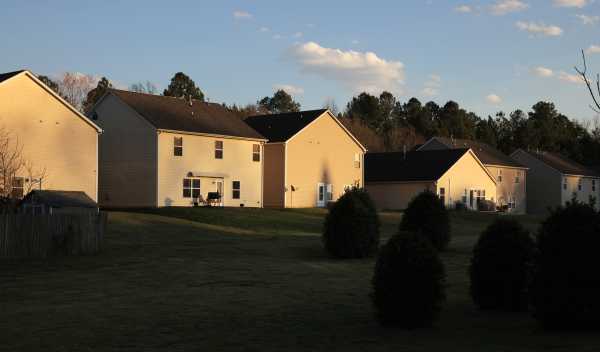
Institutional housing investors — largely, the commercial banks, private equity, and other financial entitles that flip homes or rent them out — have been the subject of conflicting media messages.
On the one hand, we’re told investors are buying up more housing than ever. In 2021, they bought nearly one in seven homes sold in the 40 largest US metropolitan areas, the most in at least two decades, according to Redfin data analyzed by the Washington Post. In the first quarter of 2022, investors comprised between one-quarter and one-third of home sales in Atlanta, Jacksonville, Charlotte, Phoenix, and Miami. The US House Financial Services Committee reported in June that corporate ownership of single-family rental homes has grown 3 percent annually since 2010, “with the third quarter of 2021 posting the fastest year over year increase in 16 years.”
These trends are worrying, researchers and advocates stress, because there’s evidence that corporate landlords, under pressure to deliver big profits to their shareholders, are more likely to evict their tenants, raise rents more aggressively, and shirk responsibility for basic maintenance and repairs. There’s also evidence that some investors have been targeting homes in Black neighborhoods at disproportionate rates, accelerating gentrification and putting homeownership for some families further out of reach.
On the other hand, housing owned by large corporate investors makes up a much smaller percentage of the nation’s overall housing stock than is often suggested by headlines. Institutional investors, referring to entities that purchase 100 or more properties, accounted for under 3 percent of home sales in 2021 and 2022, according to Freddie Mac. So-called “mom-and-pop” investors, who own fewer properties, are growing at faster rates, and according to the National Rental Home Council, only 1.16 percent of single-family rental homes were owned by rental companies. Americans for Financial Reform estimated that as of June 2022, private equity firms owned about 3.6 percent of apartments and 1.6 percent of rental homes.
Defenders of the sector point to research showing that most people moving into single-family rentals are poorer, younger, have worse credit, have larger families, and are more likely to be single parents than their home-owning counterparts. One study published last year estimated that 85 percent of single-family rental residents would not qualify for a mortgage. Taking away these rental options, advocates warn, would just take away more spacious living arrangements for younger families who can’t yet afford to own, or might not want to even if they could.
Others say the focus on Wall Street investors is largely a scapegoat to avoid wrestling with the real culprit of the housing crisis: the dearth of available units. Sam Khater, the chief economist of Freddie Mac, cited labor shortages, land use regulations, zoning restrictions, political opposition to new housing, lack of developers and lack of land as root causes of the housing shortage. And economic research published this summer found that remote work has also increased US aggregate home prices by 15.1 percent since late 2019.
Still, with damning press and congressional investigations into corporate housing abuses, political pressure has mounted on lawmakers to step in. In August, senators heard testimony from people like Laura Brunner, the president and CEO of the Port of Greater Cincinnati Development Authority. Brunner detailed how institutional investors have upended their local housing market, and dramatically hiked rents in the process. “We’ve been told by institutional investors that they only own about 1 percent of single-family homes; however … this could mean 50 percent of the houses on a single street,” she testified. “When the geographical impact is so concentrated, it has a game-changing effect on what it means to live in that neighborhood.”
In late October, three Democratic House members from California — Reps. Ro Khanna, Katie Porter, and Mark Takano — introduced a new bill, the Stop Wall Street Landlords Act, to address these growing concerns. Senators have also been getting involved, holding listening sessions with renters and housing policy experts. A spokesperson for Sen. Sherrod Brown told me that Brown is focused on “predatory investors and landlords — particularly deep-pocketed investors taking advantage of new technologies” that price out families from homes and leave tenants with unsafe living conditions. Brown is currently working on “legislative steps to protect families and address these predatory practices,” the spokesperson said.
Khanna said he doesn’t see his new bill as a comprehensive housing solution, and stresses that lawmakers need to stay focused on fighting barriers to new housing construction, increasing housing supply, and expanding down-payment assistance. “But we don’t need to be subsidizing institutional investors to go buy up housing in working-class neighborhoods and holding them for appreciation and turning them into Airbnbs,” he told me. “You could make an argument that it was necessary to subsidize Wall Street investors after the 2008 financial crisis when the market collapsed, but that certainly now has run its course.”
The Stop Wall Street Landlords Act, explained
The stated goal of the new House bill is to deter future institutional investments into single-family homes. It would try to do this in a few ways, including by barring corporate investors from claiming certain tax breaks like the mortgage interest deduction, and imposing a transfer tax on the sale value of new single-family home purchases.

The legislation also would bar the government-sponsored mortgage companies — Fannie Mae, Freddie Mac, and Ginnie Mae — from assisting certain large investors in financing, and would establish a new tax credit to help affordable housing developers build and rehab homes in low-income areas.
Groups representing institutional investors, unsurprisingly, have come out strongly against the bill. A spokesperson for the American Investment Council, which represents private equity companies, told Vox that “this politically motivated legislation completely misses the mark and won’t help address the real challenges in today’s housing market.”
David Howard, executive director of the National Rental Home Council, told the Mercury News he believes the bill “will only reduce the availability of single-family rental housing while making it more expensive — ultimately hurting the very people for whom access to affordably priced rental housing is so essential.”
Kristin Siglin, vice president at the National Community Stabilization Trust, a nonprofit that transfers foreclosed and abandoned properties to local housing groups, praised the bill’s inclusion of the neighborhood homes tax credit, which was also included in the Build Back Better bill the House approved last year.
Siglin told me the coalition she leads to promote the tax credit was “really pleased” to see the measure included, and commended the Stop Wall Street Landlords Act for not only including sticks in the form of ending tax preferences for corporate investors, but also carrots, like the tax credit, to increase the supply of homes to sell to owner-occupants. Right now, large corporate investors are often the only entities available with the financing capabilities to make repairs on homes. The neighborhood homes tax credit, Siglin says, can help to fill this gap, and keep more properties out of Wall Street hands.
Khanna’s office said they worked with experts including the Urban Institute to develop their bill. The Urban Institute’s government affairs manager, Victoria Van de Vate, told me she hasn’t read the Stop Wall Street Landlords Act and said her think tank does not suggest bill language or take official positions on legislation. “A team of housing researchers and I met earlier [in November] with Rep. Khanna and his team to discuss policy alternatives to increase rates of black homeownership and the role of institutional investors in the housing market,” she said. “It was a good conversation, and we always welcome the opportunity to share our research, answer questions, and provide evidence-based recommendations about policy.”
Laurie Goodman, the founder of the Housing Finance Policy Center at the Urban Institute, told me separately that she sees Khanna’s legislation as a very “punitive bill” that would deter institutional investors from buying properties in a way that would be unhelpful. The single-family rental industry does a lot of good things, she added, “all of which are ignored by the critics.” Goodman was not familiar with the neighborhood homes tax credit but argued that institutional investors play an important role in financing repairs that prospective homeowners can’t afford.
Dan Immergluck, a professor of urban studies at Georgia State University who has researched the history of institutional investors on housing markets, told me that while he hasn’t had time to closely read the bill, he does not support allowing Fannie Mae and Freddie Mac to help finance large-scale single-family rental operations unless there were “serious strings” attached, like affordability requirements. Immergluck said he’s less convinced simply making it more expensive for single-family rental operators to do business through measures like excise taxes will be effective, “because in places where they already have market power, they could pass those costs onto tenants.”
Where the corporate housing sector is likely going
What about inflation and the much-discussed housing construction slowdown sparked by rising interest rates? Increased building costs have already led to a slowdown in investor homebuying — a decline of 30 percent in the third quarter of 2022, the Wall Street Journal recently reported. Redfin also just closed its own home-flipping business, following Opendoor Technologies, another online house flipper, which just posted record losses.
Khanna told me he thinks his bill would help stabilize some of the rising rents by decreasing demand from institutional investors, which still accounted for 17.5 percent of all home sales in the third quarter of 2022. Even if institutional investors only buy up a small percentage of total housing, their presence in the bidding wars can still lead to higher costs for all buyers. And even though investor sales growth has slowed, experts expect their share of purchases to rise again soon, as builders with unsold homes look to sell to rental landlords. Plus a widely expected recession could raise unemployment and make it even harder for traditional buyers to compete with corporate bidders.
While investment firms began purchasing foreclosed homes after the housing crash, investors more recently have been pouring billions of dollars into new build-to-rent communities in more than 25 states. The National Association of Home Builders reported 13,000 such homes were started in the first quarter of 2022, up 63 percent from a year before. In November the CEO of Tricon Residential, a Canadian real estate company, said on an earnings call Tricon has nearly $3 billion it plans to use to buy and build new homes.
The Stop Wall Street Landlords Act will not tackle the housing shortage, Khanna acknowledged, but maintained it’s a necessary part of the legislative puzzle. “We need to massively increase housing supply, we need to figure out creative programs for first-time homeowners, and we need my new bill, which will stop the financialization of housing.”
Sourse: vox.com






